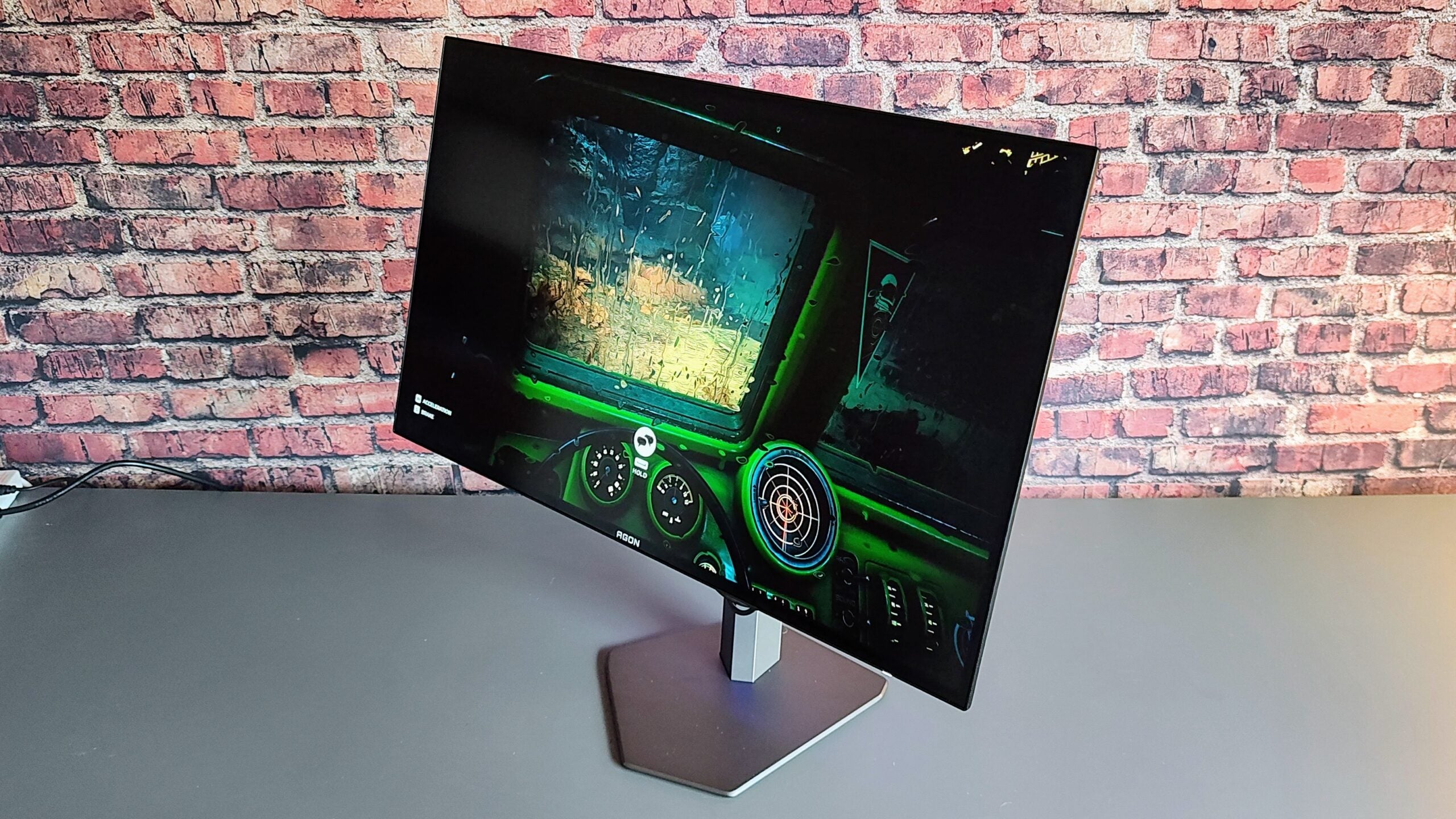Samsung Odyssey Neo G9 Review
One of the best gaming monitors ever made
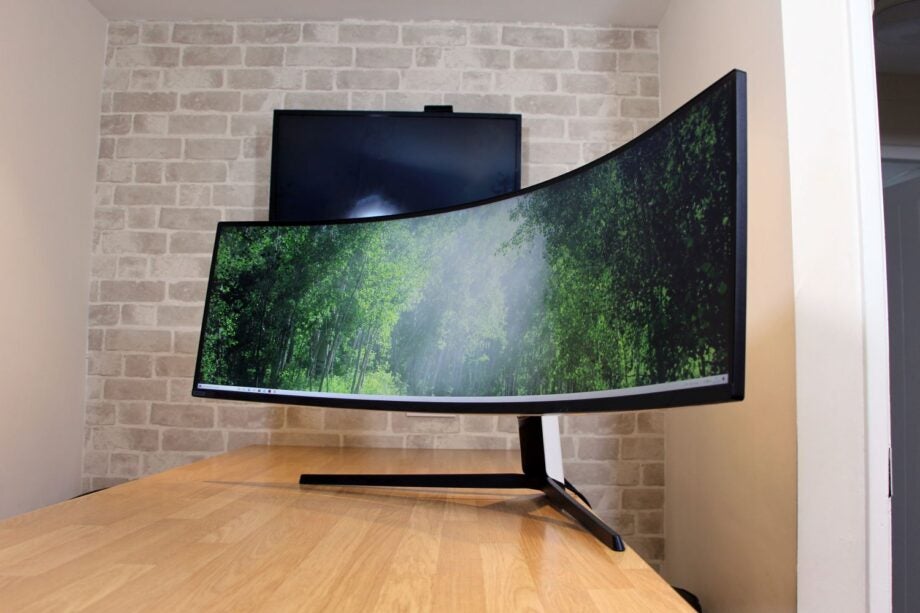

Verdict
The Samsung Odyssey Neo G9 has stunning SDR and HDR performance, superb colour accuracy, great refresh rate ability and an immersive widescreen form factor. It’s not cheap and it won’t suit everyone, but it’s one of the best gaming monitors ever made.
Pros
- Show-stopping HDR and SDR ability
- Bold, accurate and vibrant colours
- Excellent refresh rate ability
- Immersive curved widescreen design
Cons
- Wallet-busting price
- 32:9 aspect ratio won’t suit everyone
- Requires a powerful graphics card
- Connectivity could be improved
Availability
- UKRRP: £1849
- USARRP: $2499
- EuropeRRP: €1998
Key Features
- Quantum Mini LEDsSamsung’s 2,048 mini LEDs deliver big boosts to brightness, black levels, HDR performance and nuance in all situations.
- Super-wide form factorThe 49in 32:9 widescreen, 5,120 x 1,440 resolution and 1000R curve create an immersive experience in most games.
- 240Hz operationThe 240Hz refresh rate means games are smooth, and the Samsung works with AMD and Nvidia graphics cards.
Introduction
The Samsung Odyssey Neo G9 is the latest version of Samsung’s biggest gaming monitor. The original G9 was one of 2020’s best displays, so there are plenty of expectations attached to the follow-up.
It’s no surprise that Samsung has turbo-charged the sequel. Brand-new Quantum Mini LED technology is used in this panel to deliver significant improvements to SDR and HDR performance.
Elsewhere, the Samsung Odyssey Neo G9 still serves up its 49in diagonal, 32:9 aspect ratio, a huge resolution and a dramatic 1000R curve in its quest to become the best gaming monitor in the world.
The Samsung Odyssey Neo G9 is stunning, but it is pricey. It’s available for pre-order with an RRP of £1849 in the UK. In the US, its RRP is a hefty $2499, and expect similar pricing in Europe.
That’s several hundred Pounds, Dollars and Euros more than the original G9, and it’s pricier than its high-end rivals too. It’s set to launch globally on 9th August 2021.
As for rivals, the Alienware AW3821DW is a 38in widescreen at 21:9, and it costs £1299 / $1365 / €1399. Then there’s the LG UltraGear 38GN950 – another 21:9 display that costs £1299 / $1299 / €1239.
Design and features
- Quantum Mini LEDs deliver huge improvements to HDR and SDR operation
- The ultra-wide form factor and 240Hz refresh rate are great for gaming
- It’s sturdy and good-looking, but lighting and connectivity could be better
The Samsung Odyssey Neo G9’s biggest change is the move to Quantum Mini LED technology. It’s Samsung’s version of the Mini LED hardware that’s making waves in the TV world, and this is the first time it’s appeared on a gaming display.
Mini LEDs have several advantages. The LEDs are tiny, for starters, allowing Samsung to include more of them than with previous technology. There are 2048 of them in the Neo G9, and they function as the panel’s backlight. This allows for vast control over the darkest and lightest shades – and everything in between – plus they can be individually deactivated to deliver perfect, nuanced black levels and contrast.
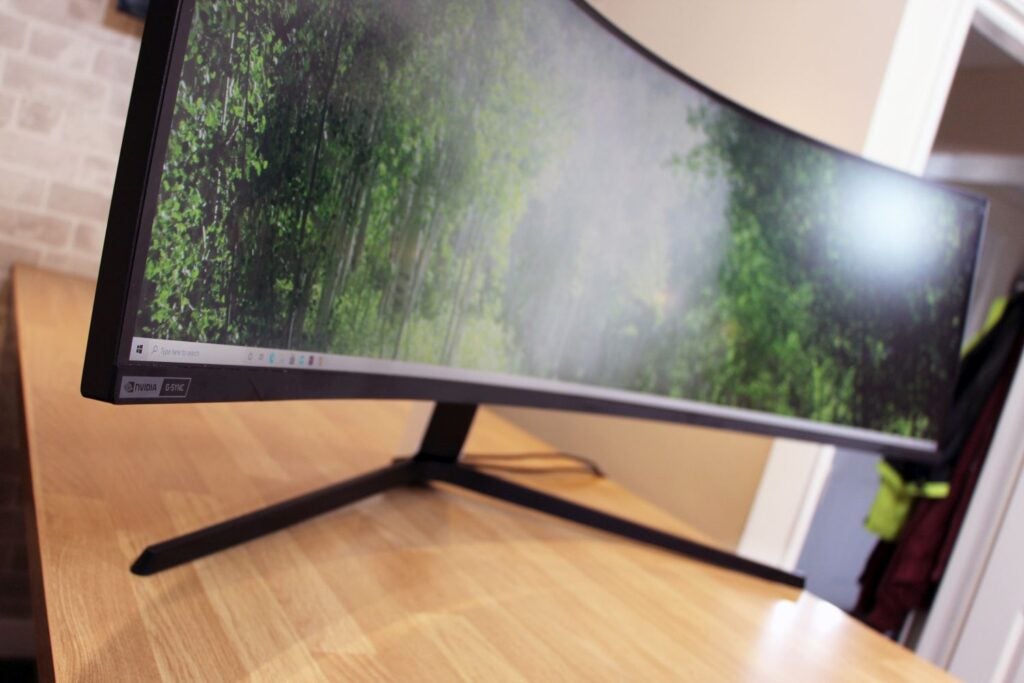
They’re brighter than conventional LEDs – Samsung claims 2000 nits, which is twice as good as the last display – and it’s a huge improvement on the 10 dimming zones of the G9.
Those mini LEDs stretch across the 49in diagonal and 32:9 aspect ratio. The huge width is brilliant for racing games and flight sims, where you get expansive cockpit views. Wide aspect ratios are ideal for RPG and adventure titles because you benefit from expansive horizons. In the vast majority of games, the Neo absorbs your attention like nothing else.
The form factor also proves its worth beyond gaming. One single screen is more effective than a multi-monitor setup due to the improved uniformity and lack of bezels, and the width is ideal for apps with horizontal timelines.
The ultrawide form factor works well with many FPS titles, although some games benefit from more vertical space. The Neo isn’t great in eSports titles, either: some competitions ban ultrawide displays, and having to move your gaze more often will cost crucial milliseconds. Also bear in mind that you’ll get black bars down the sides of movies and TV shows.
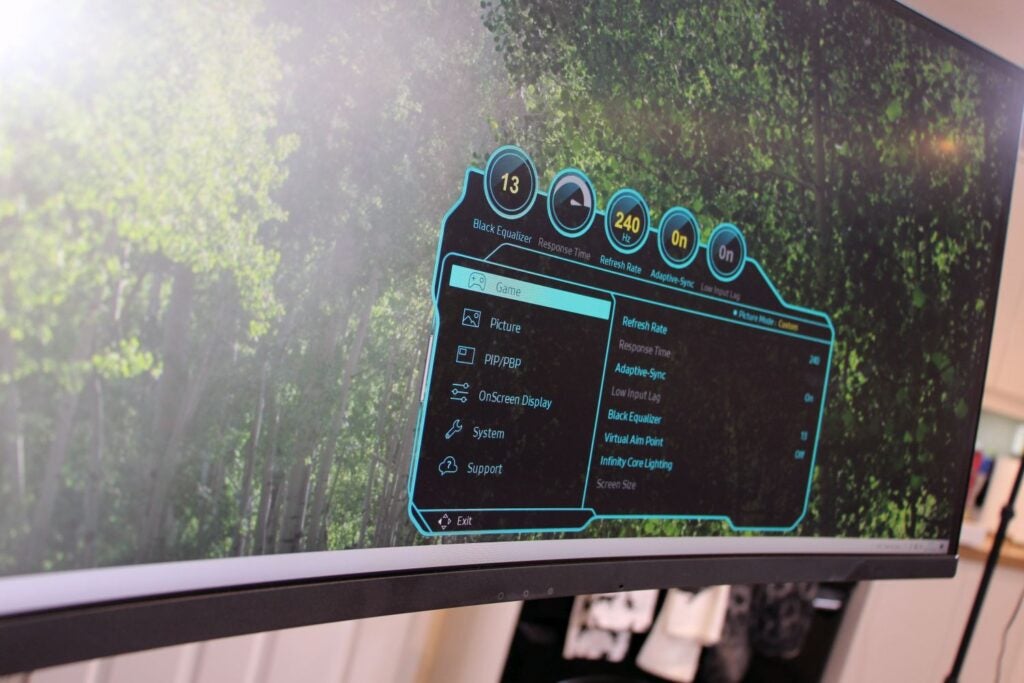
Neither of the Samsung Odyssey Neo G9’s rivals have mini-LED technology, so they can’t compete on that front, and those displays both have 38in designs, 21:9 aspect ratios and 3840 x 1600 resolutions. You lose width, but you gain vertical pixels and a resolution that more GPUs can handle.
The Neo’s 5120 x 1440 resolution remains from the original G9, and it’s still superb. As ever, bear in mind that you’ll need a suitably beefy graphics card to power this panel: ideally an Nvidia GeForce RTX 3080 or RTX 3090, or an AMD Radeon RX 6900 XT.
The 1000R is still impressive a second time round. It’s tighter than the 2300R curve on the LG and Alienware panels, and it does a great job of lining up with the human eye to keep viewing angles consistent.
The Neo uses a VA panel with a superb 1ms response time, and Samsung says it’ll render 100% of the sRGB gamut and 90% of the DCI-P3 gamut. It uses 10-bit colour with 12-bit depth, which should deliver smoother gradation. The Neo runs at 240Hz with AMD FreeSync Pro and it’s G-Sync compatible, so you’ll get smooth gaming on any GPU.
The LG and Alienware both use IPS displays with 10-bit colour and 1ms response times, so they’re comparable with the Neo in those departments. Their refresh rate is limited to 144Hz, though – good enough for high-end gaming but unable to compete with Samsung’s 240Hz.
On the outside, the Neo still has a sleek design: slim bezels at the front and glossy white plastic at the rear. Build quality is superb, although you’ll need a hefty desk to accommodate the monitor, which weighs 16.7kg and is 1151mm wide.
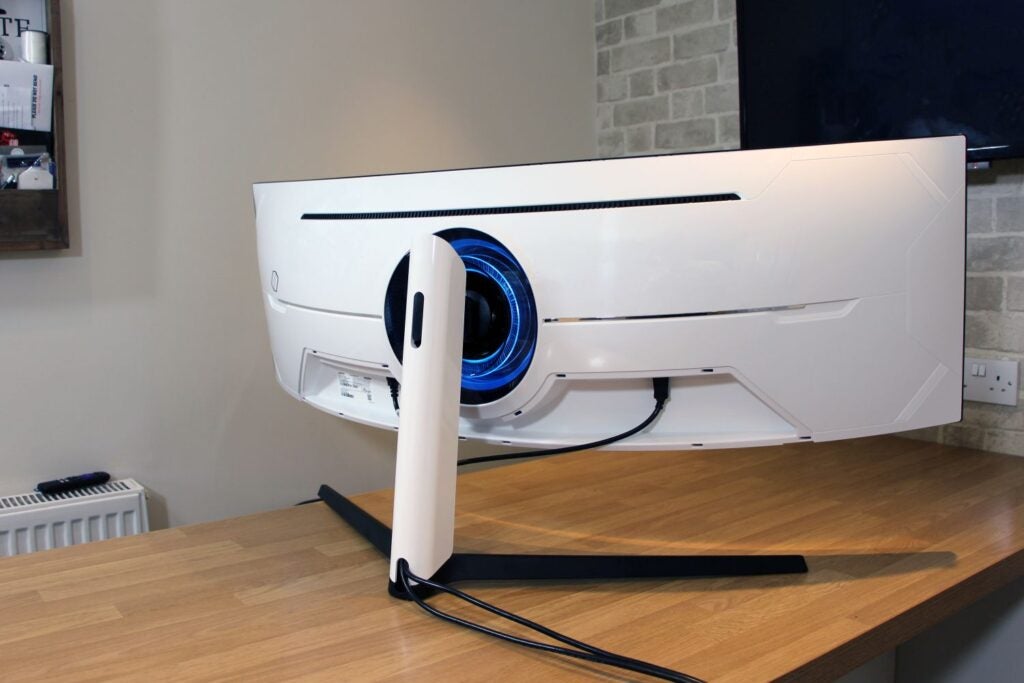
Like the G9, the Neo is tricky to build thanks to an abundance of fiddly screws, but it’s got 120mm of height adjustment alongside swivel, tilt and 100mm VESA mount support, which is more than what most ultrawides have. Elsewhere, the on-screen display is slick and helpful. The Neo has shortcut buttons to switch between settings profiles, and it auto-switches between image sources.
Connectivity is handled by two HDMI 2.1 ports and a DisplayPort 1.4 connection. Those HDMI ports are better than the HDMI 2.0 sockets included with the first G9, but the DisplayPort socket is still the only one to use if you want to enjoy the Neo’s full feature set. Elsewhere, there are two USB 3.0 ports but no USB-C or Thunderbolt, which is disappointing.
The lighting is a little disappointing too. The Neo still has its ring of RGB LEDs, but they’re still only configurable in fifty-two colours – the full RGB LED gamut would be welcome. The Neo also has a feature called CoreSync, which matches the lights to the colours produced in games. It’s supposed to produce immersive ambient lighting, but the lights are too far back in the panel and they’re not bright enough.
Image quality
- The Neo G9 has incredible contrast and depth in SDR and HDR content
- Colours are bold, accurate and vibrant – games look fantastic
- Games run smoothly, but you’ll need a hefty GPU to use this display
As well as using my naked eye for testing, I also used a colorimeter to determine the Samsung Odyssey Neo G9’s benchmark results.
In its factory SDR settings the Neo sits at a brightness level of 212 nits with a stunning black point of 0.05 nits, and that delivers a sensational contrast ratio of 4240:1. That’s twice as good as the original G9 and shows how well those mini-LEDs work. The huge contrast and deep black point means that games and films have incredible punch, subtlety and depth.
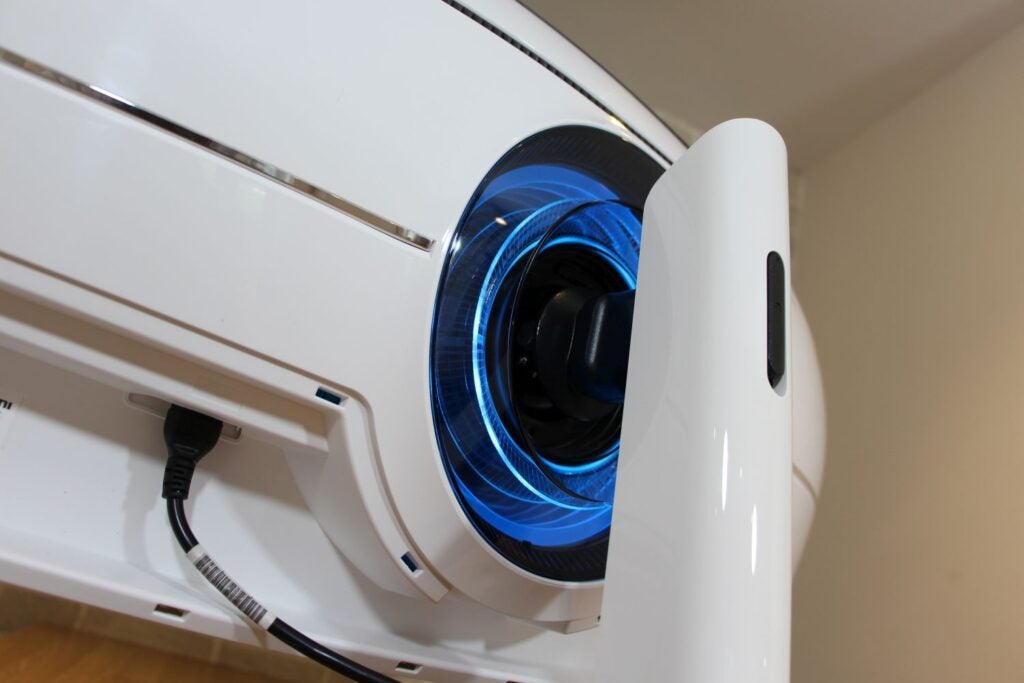
The Delta E of 1.9 ensures accuracy, and the colour temperature of 6192K is fine. Those good colour figures were paired with impressive gamut ability: the Neo rendered the sRGB gamut with coverage and volume levels of 99.5% and 129.4%, and it zipped through the DCI-P3 at 91.5% and 91.6%. That means huge vibrancy in the sRGB space and enough depth to handle HDR content.
The Neo’s uniformity is impressive, with less than 10% brightness variance – a great result for an ultrawide. Happily, the Neo maintained these results with the backlight dialled up and reduced.
Unsurprisingly, the competition from LG and Alienware just can’t compete. They’re good panels, but their contrast ratios can’t match the Neo, and the LG option suffered with poorer uniformity.
Switching over to HDR mode sees the Neo G9 shine – quite literally. The Neo has Standard and Dynamic HDR modes, and the latter is best. With the Dynamic option deployed the Neo delivered a sensational peak brightness level of 2333 nits alongside a black point of 0.05 nits, which means a mighty contrast level of 46,660:1. In some situations those black levels will hit zero, too.
There’s a huge gain in HDR games: brighter areas have fantastic punch and environments have unbeatable depth. There’s a vast range of colour between those two points, and the Neo renders those with incredible nuance. It’s the best HDR gaming monitor on the market by some distance. The move to more than 2000 dimming zones means there’s huge subtlety in how changes are rendered – a big improvement on the blunt force approach of the first G9.
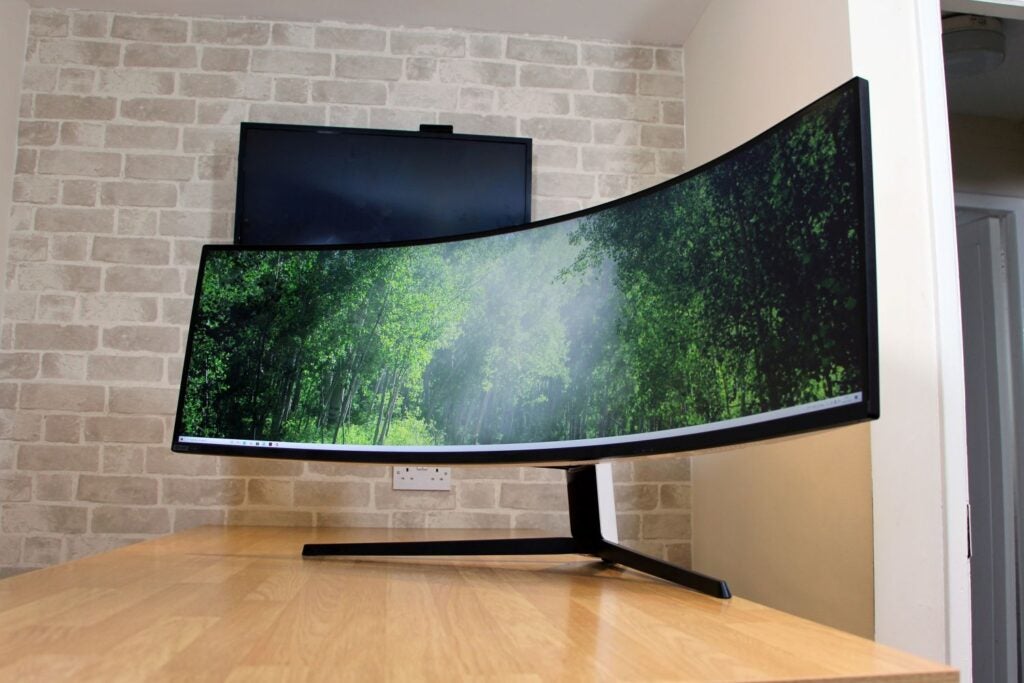
There are some issues here, but they’re tiny. There’s slight blooming when light content sits alongside dark areas, and the panel becomes a little discoloured around the edges when the screen is light. These issues will not be problematic during gameplay and the Neo is still miles better than any other display, but enthusiasts should be aware. The Standard HDR mode isn’t as good as the Dynamic option, either: its brightness level is halved and white text struggles against black backdrops.
This is another area where neither the LG or Alienware can compete. Their conventional hardware only adheres to VESA DisplayHDR 600, while the Neo goes beyond VESA entirely. So while you do get a modest HDR boost on the LG and Alienware displays, the Neo is leagues ahead.
The final piece in the gaming puzzle is refresh rate ability, and the Samsung performs extremely well here. The 240Hz refresh rate delivers smooth, sharp motion, with only a tiny bit of ghosting if you look closely. It’s better than the G9 and you won’t notice any negatives during gameplay.
The Neo has Standard, Faster and Extreme response time options. They’re all excellent and all similar. They’re disabled if you use syncing, so stick with FreeSync or G-Sync.
The Neo’s 240Hz performance is faster and smoother than its 144Hz rivals, although higher refresh rates do deliver diminishing returns so the LG and Alienware devices remain smooth and perfectly usable. The only gamers who won’t be content are eSports enthusiasts who prefer 360Hz panels.
Should you buy it?
You need the biggest, brightest, boldest gaming experience: The Neo outstrips rivals with its SDR and HDR performance, and its vibrant imagery is joined by an immersive design and huge resolution. There are few better gaming experiences.
You’re on a budget, you don’t play HDR games or you’re an esports fan: The Neo is expensive, and it’s not worth it if you won’t make use of every feature or if you don’t have a high-end GPU. Big eSports fans would be better with a 360Hz display, too.
Final thoughts
The Samsung Odyssey Neo G9 has incredible SDR and HDR performance, with brilliant contrast and bold colours, and its form factor makes it immersive and engaging. The refresh rate and response times are great, too. It’s one of the best gaming monitors ever, but it won’t suit every situation and it’s extremely expensive.
How we test
We use every gaming monitor we test for at least a week. During that time, we’ll check its design, features and how easy it is to set up.
We check its colours and image quality with a colorimeter to test its coverage and the display’s quality. We will also play numerous of games to determine its performance.
We played a variety of games on the Neo G9 to judge image quality.
We used a colorimeter to collect benchmark data.
We used the product as our main monitor during testing.
We tested the monitor with both factory settings and pre-set modes..
FAQs
The Neo has a one-year parts and labour warranty.
The Samsung is packaged with HDMI, DisplayPort and USB 3.0 cables.


